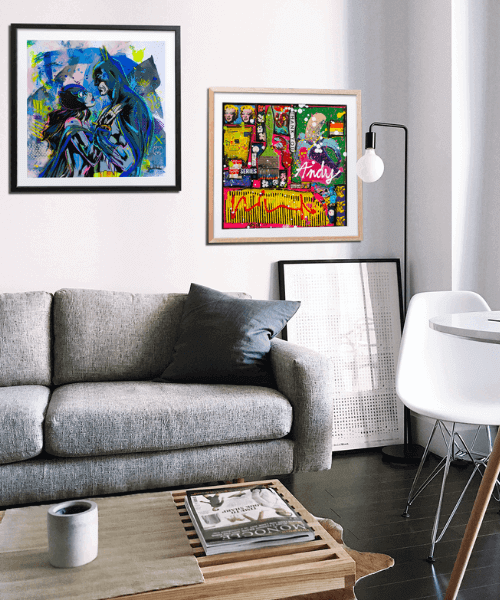Understand the difference between modern and contemporary art
Modern art and contemporary art are two distinct artistic movements.
The emergence of photography in the 19th century fostered the emergence of modern art.
Contemporary art has developed on the experiments of modern art.
Contemporary art reflects the crises of society. It challenges and prompts a reflection that goes beyond the aesthetics of the work.
How to choose a contemporary artwork? What is the difference between modern and contemporary art?
Here is a light on two artistic trends often seen as synonymous.
Summary
- Two distinct movements in the history of art
- The context of the emergence of modern and contemporary art
- Emotion and reflection in modern and contemporary art
- The social impact of contemporary art
- The compartmentalization of artistic practices
- Expressive modern art and contemporary art that challenges
Two distinct movements in the history of art
Modern art and contemporary art are two distinct movements in the history of art.
They are often confused when talking about modern and contemporary art.
Indeed, the term "modern" is often used to refer to recent art.
In reality, this art is very contemporary. Modern art refers to the period from the 1870s to the 1960s.
The birth of contemporary art takes place after World War II and in particular from the 1960s with the emergence of pop art.
All artistic works produced until today by living artists are part of contemporary art.
Le contexte de l’émergence de l’art moderne et de l’art contemporain
While modern art intends to break with classical figurative art, contemporary art is born in the post-war period.
This period changed artists and their influences. The traumas of war push artists to try to shape a new identity.
From this need for renewal will emerge various artistic movements in Europe as in the United States and Japan.
Many artists from the European avant-garde moved to New York, which became the new artistic capital after Paris.
identité.
Emotion and reflection in modern and contemporary art
Introspection is a very popular practice in literature and the arts. Modern artists transcribe their emotions through different mediums and various artistic techniques.
This diversity gives rise to several artistic movements such as Impressionism, Cubism, Surrealism, Abstract Expressionism, etc.
On the other hand, contemporary art brings together artists who reveal a vision that is sometimes political, sociological, identity-based, distorted or in relation to contemporary events.
They experiment, seek and question the representative functionality of artworks.
Art is no longer necessarily figurative. While modern art arouses emotion in the viewer, modern art questions and prompts a reflection that goes beyond the aesthetic of the work itself.
.png)
2.png)
The social impact of contemporary art
Unlike modern art, contemporary art has a social impact.
Contemporary artists enjoy great freedom to experiment and give free rein to their creativity.Modern artists favor the idea of purity of art while contemporary artists care less about purity of art and explore new art forms.
The works arouse the curiosity of spectators. Contemporary art challenges the notion of artwork, thus giving it a broader meaning.
The compartmentalization of artistic practices
The compartmentalization of artistic practices
Contemporary art uses both traditional fine art techniques and creations such as posters, photographs, videos, digital art, etc.
Artistic creation therefore has no limits for the contemporary artist. Moreover, he rejects the partitioning between artistic disciplines (painting, sculpture, etc.) as is the practice of modern art.
Expressive modern art and contemporary art that challenges
While modern art is expressive, contemporary art questions and prompts reflection on the structures of society.
Where modern art favors the uniqueness of the work, contemporary art experiments with new artistic forms.
The uniqueness and uniqueness of the modern artwork
Modern art promotes the expressiveness of the artist. The representation of the world is that perceived by the artist himself.
To do this, he resorts to plastic or expressive deformations which constitute an art form in themselves: abstract expressionism, lyrical abstraction, etc.
Emotion arises from the beauty of the plastic expression of the work. Uniqueness and uniqueness are two essential characteristics of a modern artwork.
Every artistic movement from Manet to Soulages, including Van Gogh, Cézanne, Matisse, Picasso, Kandinsky, Chagall, Mondrian, Bacon, Pollock, Rothko, etc. brought a plastic revolution: impressionism, fauvism, cubism, etc.
Representation and discourse in contemporary art
Unlike modern art, which favors an internal meaning over forms and colors, contemporary art favors representation and meaningful discourse. Contemporary art questions all the structures of our society, starting with itself.
It puts an end to the uniqueness of the work. The pop art movement is a telling example. Contemporary art highlights materials for the meaning they have.
Complementary articles
On the subject:
Choose a contemporary artwork
find out more :
- What is contemporary art?
- History of contemporary art
- Currents of contemporary art
- Well-known contemporary artists



